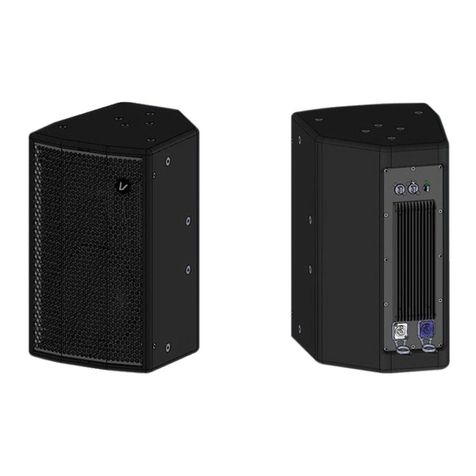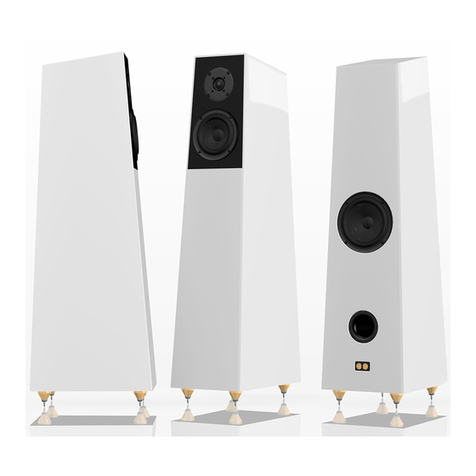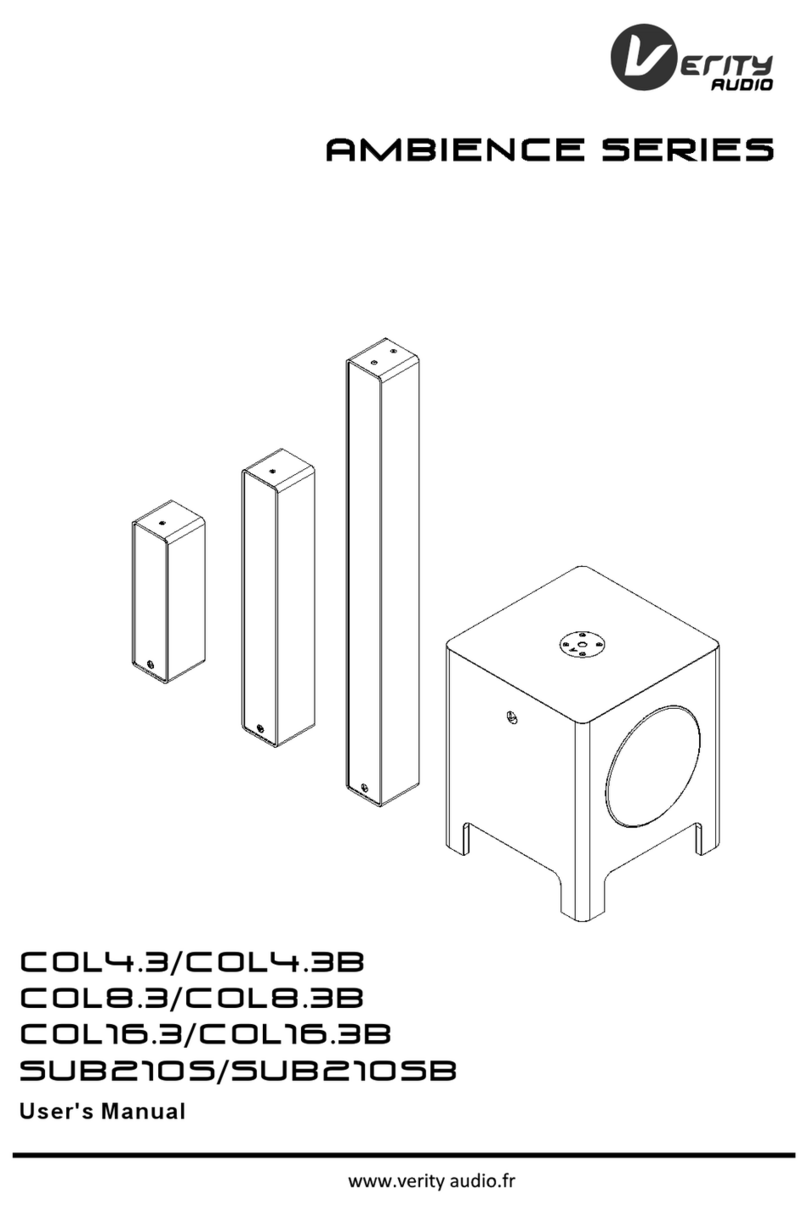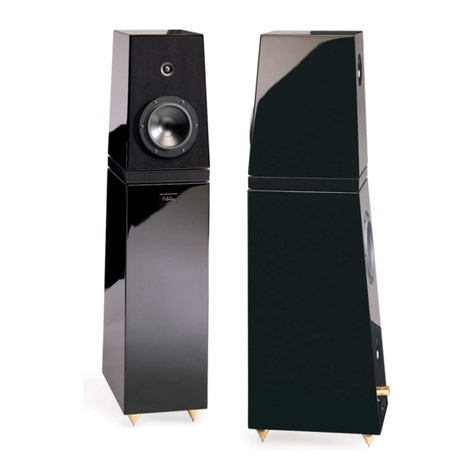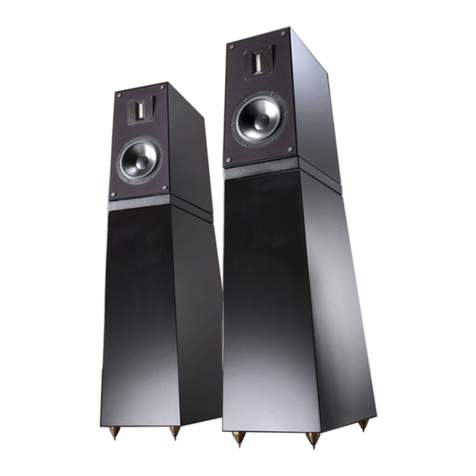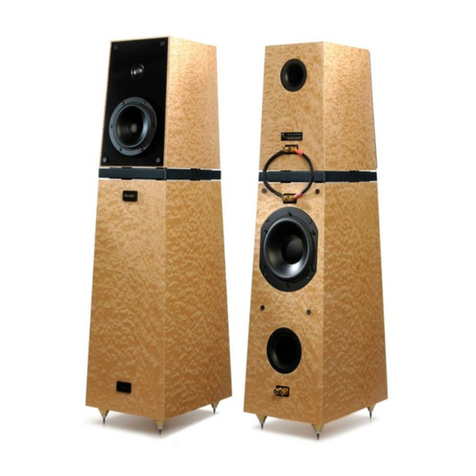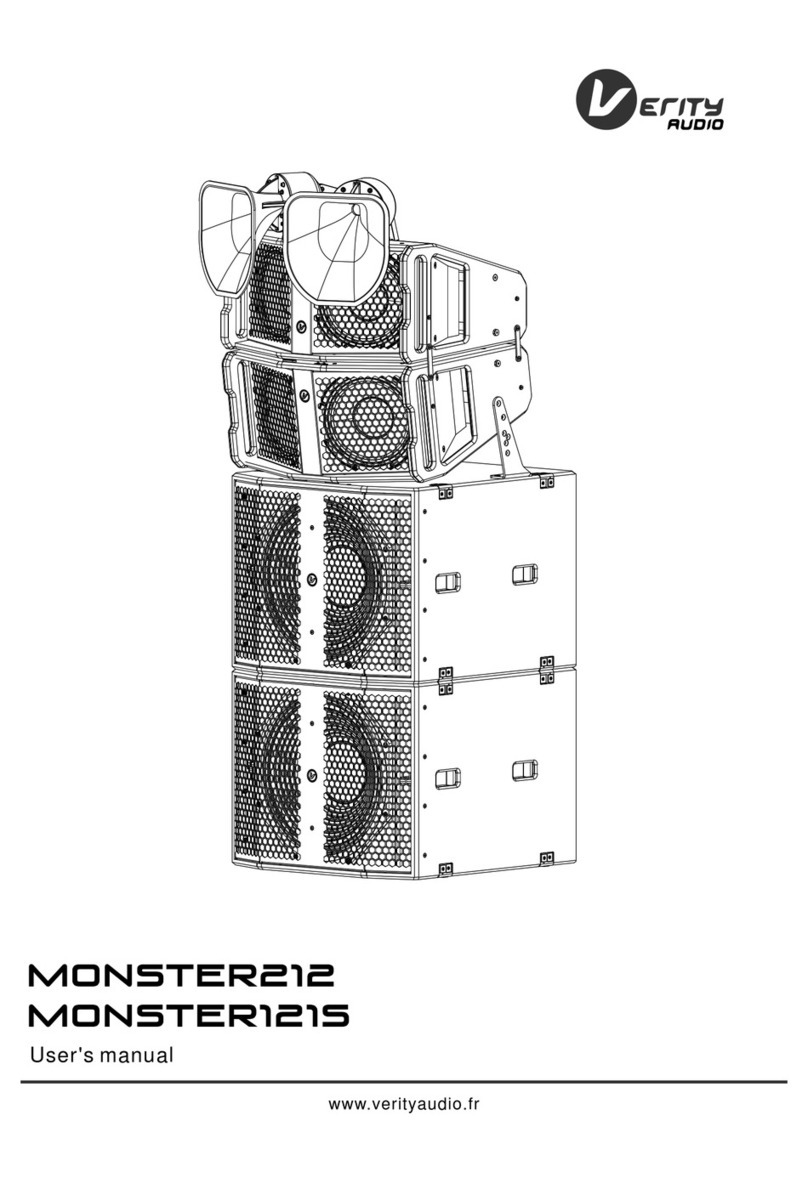
Florestan
R1.0
OWNER’S MANUAL
August 2023
VERITY AUDIO PAGE 7
your room characteristics, i.e., which surfaces are absorptive or reflec-
tive, the area of these surfaces and the selection of acoustical materials.
The flutter echoes are an acoustic phenomenon that occurs in a room
when sound waves repeatedly reflect between two parallel surfaces,
such as two opposite walls or the floor and the ceiling. These successive
reflections create a fast and repeated series of echoes that sound like a
«flutter» or beating noise.
The flutter echo is easily recognizable: it manifests as a series of clear
and distinct sound repetitions after an initial noise, such as the clapping
of hands. This phenomenon can degrade the sound quality in a room,
making music or speech unpleasant or difficult to understand.
To treat or prevent flutter echoes, acousticians can use absorbent ma-
terials or diffusers to disrupt sound reflections between parallel surfaces.
Reverberation is an acoustic phenomenon where sound persists in an
environment after the cessation of the original sound source. This phe-
nomenon is due to the multiple reflections of sound on the surfaces of
a room, such as walls, the ceiling, and the floor, before finally being ab-
sorbed. Reverberation gives a space its particular sound characteristic.
For example, a church or a cathedral will typically have a long reverbe-
ration, giving a sense of space and grandeur.
The «reverberation time» is a measure used to quantify reverberation.
It is defined as the time needed for the sound level to decrease by 60
decibels after the cessation of the sound source.
The optimal reverberation time for reproducing music depends on the
type of music and the size of the room. However, for most music halls
and recording studios, a reverberation time between 0.4 and 0.6 se-
conds (for frequencies ranging from 500 to 1,000 Hz) is often conside-
red ideal. This time allows sufficient clarity to distinguish the details of
the music while providing a sense of space and richness. It is important
to note that this is only a generalization and that certain musical genres
or performances might benefit from a different reverberation time.
A standing wave is a phenomenon that occurs when a sound wave
is reflected off a surface and interferes with itself. This creates areas of
maximum (nodes) and minimum (antinodes) pressure that remain sta-
tionary in space. A properly proportioned room distributes sound reflec-
tions evenly, thus reducing the formation of standing waves. Through
acoustic treatment, one can control the levels of standing waves by
using absorbers to reduce reflections and diffusers to disperse sound.
If you suspect the presence of standing waves in your space, we advise
you to contact your dealer to receive advice tailored to this situation.
re reflections from opposing parallel surfaces resulting in audible peaks
and dips in the reverberation time / frequency curve. In properly pro-
portioned rooms, resonances can be effectively reduced and standing
waves practically eliminated by introducing sound treatment devices.
The object is to prevent sound reflection from going back to the point
of origin until after several reflections and/or after being considerably
attenuated. Once again if you feel having a standing wave problem in
your room, please consult your dealer to get proper assistance on this
matter.
Early reflections refer to the first sound waves that are reflected by
the surfaces of a room (walls, ceiling, floor) before reaching the liste-
ner’s ear, following the initial directivity of the speaker.
These reflections can have a significant impact on the listener’s sound
perception. If not well managed, they can blur the stereo image, alter
the tonal balance, or introduce other perceptual anomalies. This is why
audiophiles and acoustics professionals often pay particular attention
to controlling these early reflections, for instance, by using acoustic
panels or other treatments to absorb or diffuse these reflections. Your
dealer can effectively assist you in this matter.
We generally favor diffusion over damping, maintaining an adequate
reverberation time in the room. A room that is too damped will quickly
sound dull or lose its liveliness.
If you choose to work with a specialized room treatment device, the
manufacturer’s instructions should be followed.
Ancillary Equipment
Your new Florestan is an extremely precise instrument that can clearly
reveal the qualities of your upstream equipment. Your Florestan perfor-
mance will be closely related to the excellence of its associated equip-
ment. Subsequently, it would be wise to invest in high-quality ancillary
equipment, as your enjoyment will be consequently rewarded.
The Florestan shows an easy impedance load for most power ampli-
fiers. It has been evaluated with a wide variety of power amplifiers and
has shown consistent results with quality solid state and vacuum tube
equipment. Superb performance can be realized from either design.
The high quality binding posts on the Verity Audio Florestan accept
banana plugs, spade connectors or bare wires. For best results, we re-
commend the use of spade connectors.
When choosing speaker cables, experimentation is the best way to find
out which ones will be the most satisfying in your installation. Your
Verity Audio Dealer can be of assistance in making recommendations.
Power Handling
The power tolerance of a loudspeaker is correlated to its maximum
voice-coil heat dissipation and to its maximum cone displacement.
These parameters are in turn stimulated by the time, amplitude and
spectral characteristics of the applied musical energy. At low frequen-
cies, the maximum cone displacement is normally reached before
maximum voice-coil temperature.
With the Florestan’s transducers, because of their superior ventilation
system, the voice-coils will most likely never reach critical tempe-
ratures. But low frequencies played at high levels can ask for a larger
cone displacement than allowed by the driver suspension. A driver rea-
ching its maximum displacement will not break unless this situation is
maintained for an inordinate period of time. Before a driver reaches its
maximum displacement, its distortion level will increase greatly and will
become audible. So when a speaker starts sounding bright and hard or
if any “cracking noise” can be heard, just lower the level until it sounds
comfortable again.
The Florestan has to be played unexpectedly loud before any occur-
rence of compression or distortion appears.
